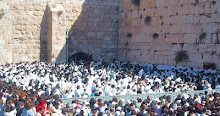Top Egyptian Daily: Joseph’s Era Coins Found in Egypt
"...discovered many charms from various eras before and after the period of Joseph, including one that bore his effigy as the minister of the treasury in the Egyptian pharaoh's court…"
The report in Al-Ahram boasts that the find backs up the Koran’s claim that coins were used in Egypt during Joseph’s period. Joseph, son of the Patriarch Jacob, died around 1450 B.C.E., according to Jewish sources.
Excerpts from the Al-Ahram report, as translated by Middle East Media Research Institute (MEMRI):
"In an unprecedented find, a group of Egyptian researchers and archeologists has discovered a cache of coins from the time of the Pharaohs. Its importance lies in the fact that it provides decisive scientific evidence disproving the claim by some historians that the ancient Egyptians were unfamiliar with coins and conducted their trade through barter.
"The researchers discovered the coins when they sifted through thousands of small archeological artifacts stored in [the vaults of] the Museum of Egypt. [Initially] they took them for charms, but a thorough examination revealed that the coins bore the year in which they were minted and their value, or effigies of the pharaohs [who ruled] at the time of their minting. Some of the coins are from the time when Joseph lived in Egypt, and bear his name and portrait.
"There used to be a misconception that trade [in Ancient Egypt] was conducted through barter, and that Egyptian wheat, for example, was traded for other goods. But surprisingly, Koranic verses indicate clearly that coins were used in Egypt in the time of Joseph...
"Research team head Dr. Sa'id Muhammad Thabet said that during his archeological research on the Prophet Joseph, he had discovered in the vaults of the [Egyptian] Antiquities Authority and of the National Museum many charms from various eras before and after the period of Joseph, including one that bore his effigy as the minister of the treasury in the Egyptian pharaoh's court…
"Studies by Dr. Thabet's team have revealed that what most archeologists took for a kind of charm, and others took for an ornament or adornment, is actually a coin. Several [facts led them to this conclusion]: first, [the fact that] many such coins have been found at various [archeological sites], and also [the fact that] they are round or oval in shape, and have two faces: one with an inscription, called the inscribed face, and one with an image, called the engraved face - just like the coins we use today.
"The archeological finding is also based on the fact that the inscribed face bore the name of Egypt, a date, and a value, while the engraved face bore the name and image of one of the ancient Egyptian pharaohs or gods, or else a symbol connected with these. Another telling fact is that the coins come in different sizes and are made of different materials, including ivory, precious stones, copper, silver, gold, etc."
One coin had an inscription on it, and an image of a cow symbolizing Pharaoh's dream about the seven fat cows and seven lean cows, and the seven green stalks of grain and seven dry stalks of grain.
"The researcher identified coins from many different periods, including coins that bore special markings identifying them as being from the era of Joseph. Among these, there was one coin that had an inscription on it, and an image of a cow symbolizing Pharaoh's dream about the seven fat cows and seven lean cows, and the seven green stalks of grain and seven dry stalks of grain. It was found that the inscriptions of this early period were usually simple, since writing was still in its early stages, and consequently there was difficulty in deciphering the writing on these coins. But the research team [managed to] translate [the writing on the coin] by comparing it to the earliest known hieroglyphic texts… Joseph's name appears twice on this coin, written in hieroglyphs: once the original name, Joseph, and once his Egyptian name, Saba Sabani, which was given to him by Pharaoh when he became treasurer. There is also an image of Joseph, who was part of the Egyptian administration at the time."MEMRI's website says it "explores the Middle East through the region's media. MEMRI bridges the language gap which exists between the West and the Middle East, providing timely translations of Arabic, Persian,Turkish, Urdu-Pashtu media, as well as original analysis of political, ideological, intellectual, social, cultural, and religious trends in the Middle East." Headquartered in Washington, D.C., MEMRI has branch offices in Jerusalem, London, Tokyo, Rome, Baghdad, and Shanghai.
SEE ALSO THIS SITE FOR MORE INFORMATION ON THE HISTORIC JOSEPH - maybe - interesting for sure:
There is also the famous video of the Red Sea crossing on that site, which some people claim is a forgery; again, I don't know, only posting the link, for you to explore further.











1 comment:
Very cool!!! Thanks for the post!
Post a Comment